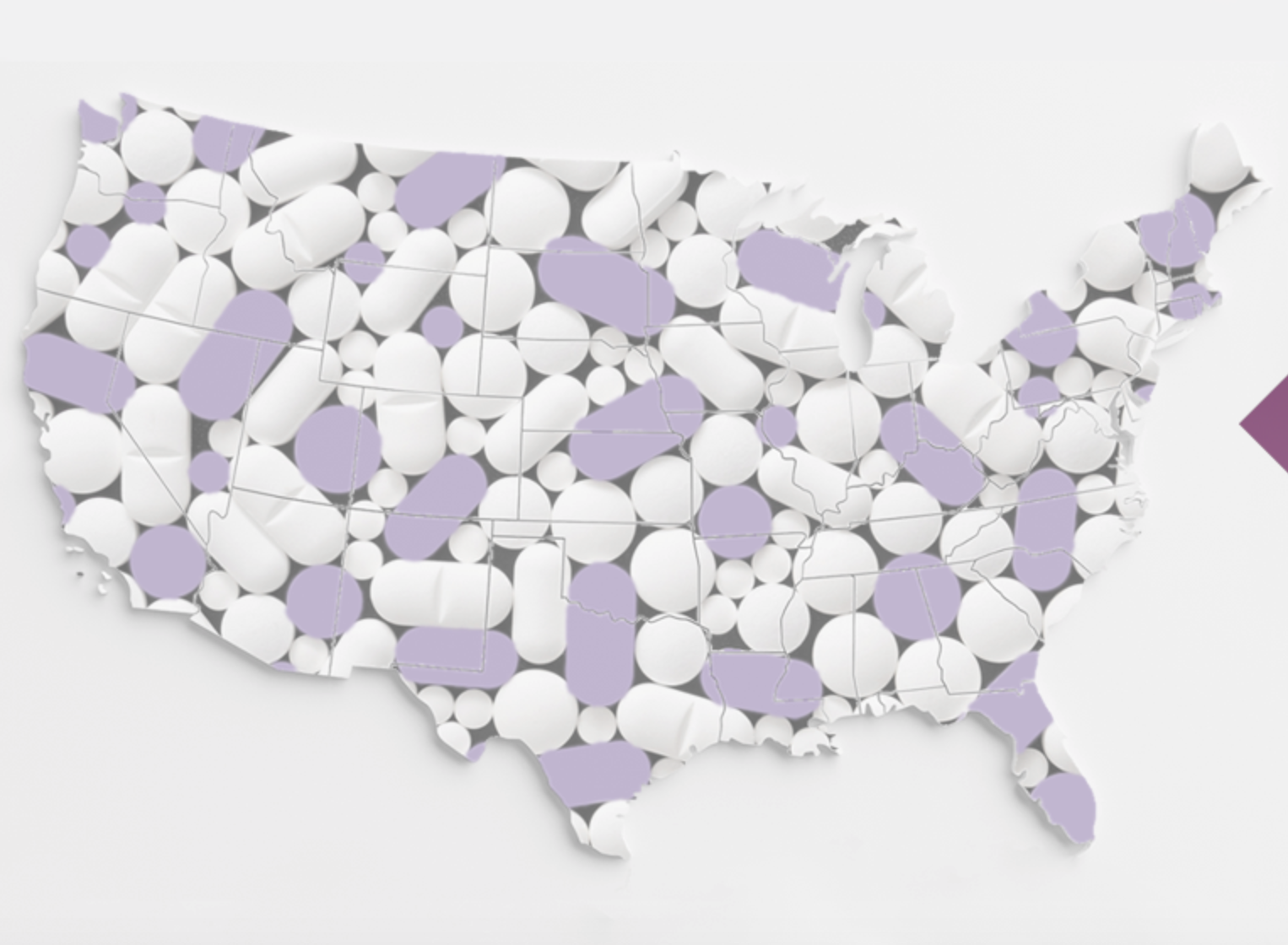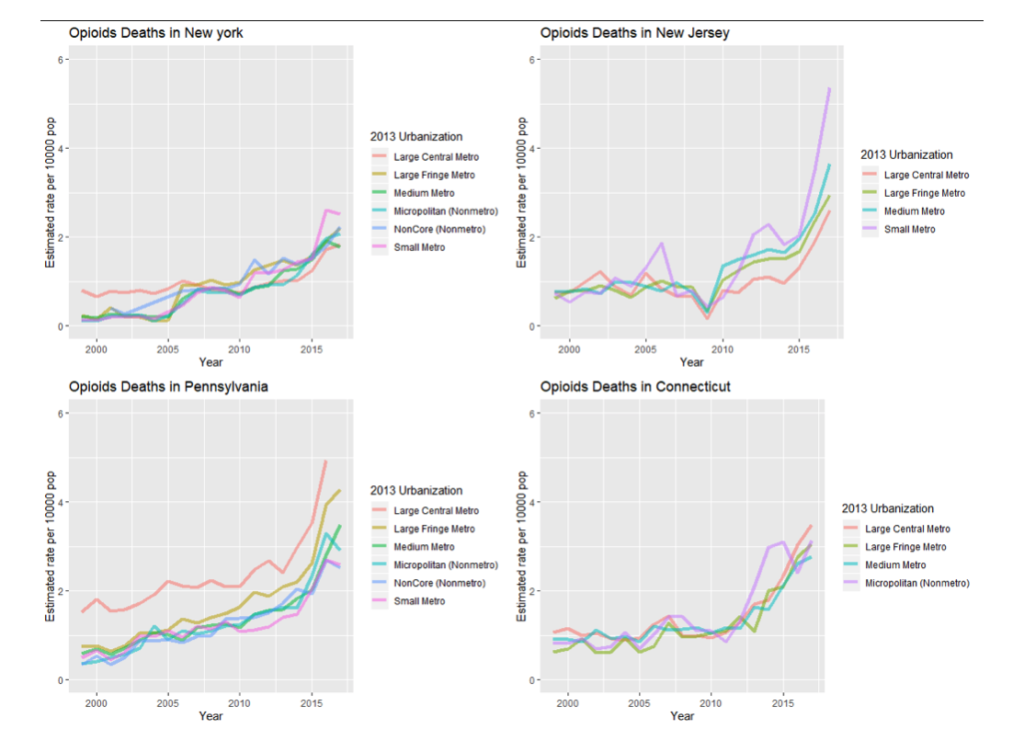Robert Utzinger
February 17, 2020
The United States has been experiencing an increase in the number of deaths due to suicide and drug overdose. In this article I first explain this problem, review the theories behind this phenomenon focusing on drug abuse; I then summarize an analytical study I conducted examining the influence of economic factors on death rates in the greater New York metropolitan region and across different urban classifications in the region.
Deaths of Despair
The concern with opioid addiction and related deaths nationwide reflects the sharp rise in deaths since 2000, seen in the chart below. This is not the first episode of increasing deaths in despair, however, as there was also a rise nationwide into the early 1930s as the great depression began. Unlike today, suicides and alcohol-related deaths were driving up the deaths in despair, while since 2000 they have been driven largely by drug-related deaths.
Deaths of Despair in the United States
Deaths of Despair is the sum of the number of suicides, alcohol-related, and drug deaths
Source: long-term trends in deaths of despair, scp report no. 4-19| September 2019
The current opioid problem dates from the early 2000s when doctors started to prescribe painkillers more often to their patients. This trend was primarily due to the development of new drug formulas that were less likely to cause addiction and to a change in the perspective on pain management. An “opioid” is a class of drugs that includes both legal versions,such as Oxycontin, and illegal versions, including street drugs such as heroin. An opioid interacts with the brain and is primarily used to dull pain in the human body. It can also create a feeling of euphoria if taken in large quantities. Thus, opioids can lead to individuals becoming dependent on them. The combination of a large push by pharmaceutical companies and an increase in the willingness of doctors to prescribe these drugs, along with a lack of oversight by the government, created a situation for people to abuse the system. The influx of easily produced drugs resulted in a large group of patients who found themselves exposed and becoming dependent. When officials started to crack down on abusers it pushed people to turn to illegal options to satisfy their cravings1. Those who didn’t have access to alternative sources of opioids were forced to go through the process of withdrawal.
There have been many theories to explain this rapid increase in the number of deaths and who it is affecting. The loss of economic opportunity, increasing income inequality, and a changing economic/social landscape have all played a part in the number of deaths overtime. The increasing number of deaths was first addressed in depth in two papers by Case and Deaton. The authors noted that middle-aged high school educated whites were experiencing a slow increase in the number of suicides, drug overdoses and alcohol deaths. Subsequently they found this trend across all Caucasians with no college degree, while a decreasing number of deaths were associated with those who had a college degree or more. In the meantime, the Black, Hispanic, and Asian populations had experienced decreasing death rates across all educational levels. The authors argued that a slow buildup of inequality across regions because of fewer job opportunities for those workers with high school diplomas has led to dissipated lives and a feeling of isolation within local communities. Thus, deaths among such workers have been coined “Deaths of Despair”; these people died because of diminished opportunities, financial wellbeing, and social interactions. Case and Deaton’s paper has inspired many follow-up papers that explore different causes of deaths across the country. This research has given rise to two main branches of study, the impact of increasing/decreasing the supply of drugs vs. the factors that change the demand for these drugs. The supply side argument implies that the increasing supply of drugs is pushing individuals to use them. This view suggests that if policymakers restrict the supply of drugs into a community it will cause individuals to stop using them. The research into the demand side estimates the impact of the economic, social, or political factors driving the demand for those drugs. This approach supports Case and Deaton’s deaths of despair argument, in that people who have experienced economic decline are turning to drugs to escape.
Opioid deaths in the Northeast region
I want to focus on four the northeastern states since they encompass a large variation in types of metropolitan areas and wealth levels. These states are particularly interesting because they are a mix of urban, suburban, and rural regions that have all been affected by varying levels of drug abuse. According to Case and Deaton’s model, if there is an increase in the minimum wage, it should increase the real wages across the states thus lowering the economic burden on the individuals. A better wage in these places can reduce the strain on individuals within those communities. Some previous research found that the increases in minimum wages had no significant negative effects on the number of individuals hired, and in one case was actually was associated with a small positive employment effect. Further research1 comparing state-by-state level shows that increases in minimum wages are associated with a lower probability of suicide and lower stress levels in individuals, but not with overall drug deaths.
The following graph shows the death rates due to various opioids per-ten thousand individuals in New York, Pennsylvania, New Jersey, and Connecticut between 1999 and 2017 annually. The data below are taken from the Center for Disease Control, the organization that tracks all deaths in the country. The deaths are broken down by state and metro type; consequently, we can see how state policies and economic factors play a role in death rates. It is important to note that the data are incomplete, as according to CDC rules if a region has fewer than ten deaths, CDC will not release the data. This practice is meant to protect the individuals’ identities as well as those of their families. As a result, regions with fewer people (generally small or non-core metro) are undercounted in the data. My model uses data for the period 2003 to 2017.
The graphs show that there is a difference in death rates between the regions, state, and metro types. It is particularly interesting to observe that deaths in large central metro regions across all years are lower everywhere except for Pennsylvania. This fact implies that, despite the interconnectivity of the regions, there must be other factors that affect the deaths in Pennsylvania differently than those in other states. There are many possible reasons for these differences across states, but the one I explored is the impact of the variation in minimum wage among the four states on their death rates, respectively. The federal minimum wage is lower than the state minimum wage in all the states except Pennsylvania, whose minimum wage is still $7.15 an hour. The focus is on the minimum wages because changes in this factor most likely affect low-skilled workers. By using a statistical method, I examined the relationship between deaths of despair, focusing on the change in minimum wages adjusted for inflation and controlling for a set of variables including the unemployment rate and poverty rate. The results show that an increase in the minimum wage rate is associated with a lower the number of deaths. The unemployment rate and the poverty rate variable were also found to be significant in explaining the death rate, as an increase in the unemployment/poverty rate increases the death rate. An interesting result, and one that needs further exploration, is that the average income by metro region was associated with an increase in the number of deaths in that metro region.
Conclusion:
Controlling for a small set of variables and despite a fairly small number of data points, we found support of Case and Deaton’s death in despair arguments in helping to explain the rise in opioid deaths in New York, New Jersey, Connecticut and Pennsylvania. The decreasing economic prospects and increasing costs of living are impacting the deaths of despair. While our model can explain a portion of the variation in deaths, more research is required to understand the factors that explain the rise in mortality rates.
This study also focused on four states from 2003 to 2017 and the relationship between wages and overdoses could be different in other regions. The opioid crisis is impacting many people and families across the country and across social economic groups. There is a still a lot of work to be done to get at what started the crisis and what can be done to mitigate it. This study is a first attempt at giving some insight into how economists view the topic, explaining some methods they have used to study the problem, and providing an understanding of how some factors affect overdoses.








